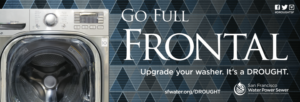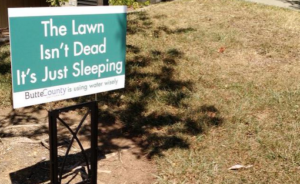As the megadrought continues, public agencies and nonprofit organizations are upping the ante on water conservation campaigns. San Francisco Public Utilities Commission is working to sex up water savings with ads that call for “quickies” (short showers) and “full frontal” high efficiency washers.

Denver Water has long used eye-catching art installations to urge consumers to “use only what you need.” In southern California, Los Angeles Waterkeeper is calling on supporters to go #dirtyforthedrought and skip washing their cars.
Social media has made it easy for people to call out water wasters. #Droughtshaming is happening on Twitter, on Instagram, via smartphone apps, and in the news, where fountain and lawn-filled communities like Rancho Santa Fe have been singled out for sky high water use.
Residents of the parched western states know water supplies are stretched to the limit. They understand we all have to do our part. A March 2015 poll found that 86% of Californians believe the state is facing “persistent water shortage,” and 82% believe it is important to conserve water regardless of whether we’re in a drought. Ninety percent said they are willing to make significant changes to their own water usage.
Of course, there is often a difference between what people say they are willing to do, and what they actually do. Behavioral pyschologists call this the intention-action gap. But will drought shaming get people to tear out their lawns or fix leaky faucets?
Based on our many years of work on energy efficiency, we think not. Our experience and that of our partners is that carrots are far more effective than sticks. Behavioral research corroborates our experience.
The problem with all these photos of high noon sprinklers and celebrity water use stats is that they make the problem feel overwhelming. If Rancho Santa Fe and the Kardashians are using millions of gallons of water, how can my toothbrushing routine possibly make a dent in our deficit?
Another March poll found that the majority of Californians feel other people need to do more to conserve. Drought shaming perpetuates perceptions that waste is the norm. What we want to do instead is mainstream conservation (scientists call this normative social influence).
There are some  smart campaigns working to do just that, like San Diegans Waste No Water and Butte County’s lawn signs. Ceres Connect the Drops campaign highlights corporate water action, and the Municipal Water District of Orange County is partnering with brands like Hurley and Jamba Juice to show how we can all “Do More with Less.”
smart campaigns working to do just that, like San Diegans Waste No Water and Butte County’s lawn signs. Ceres Connect the Drops campaign highlights corporate water action, and the Municipal Water District of Orange County is partnering with brands like Hurley and Jamba Juice to show how we can all “Do More with Less.”
Many groups are using photos to show how beautiful conservation can be. California’s Save Our Water campaign describes drying lawns as gold, not brown, and includes an idea gallery for drought tolerant landscapes. Photos of drought tolerant landscapes celebrate beautiful native plants and recognize the work of #droughtchamps.
Our research shows that imagery can be a powerful tool for driving conservation, especially when it shows real people taking action in their homes and workplaces.
Have you seen any great water conservation messaging or visuals? We’d love to hear about it!




